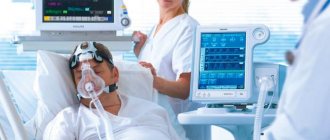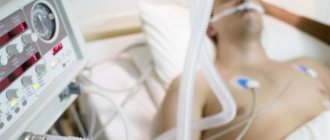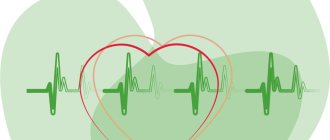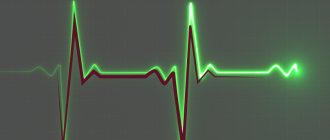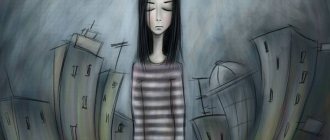The concept of “coma” is quite broad and represents a set of symptoms. Most often they talk about coma when a person is unconscious and often does not respond to external stimuli. In severe cases, this condition leads to death - usually they talk about such risks in a IV degree coma.
In this case, there are two types of coma - natural and artificial. Moreover, mentions of the second are often found in various medical news. But what is the difference between these two types?
Between life and death. How does a person in a coma feel? More details
Content:
- Features of coma in drug addicts
- Why does a drug-induced coma develop?
- Signs of a drug-induced coma 3.1. How coma begins in drug addicts 3.2. Progression of drug-induced coma
- How is drug-induced coma treated?
The consequences of a drug-induced coma are terrible. Very often this condition leads to disability, mental disorders and death. You shouldn't even try to treat it yourself. By delaying contacting a narcologist, the addict risks death.
Prevention of complications after tooth extraction
- Responsible choice of clinic and doctor is one of the most important conditions for successful treatment.
- X-ray monitoring of all performed manipulations allows timely detection and prevention of complications.
- Compliance with all dentist recommendations for oral care after surgery.
- Timely installation of an implant helps to avoid changes in bite.
- A thorough medical history allows you to choose the right anesthesia and calculate its dosage.
- Reducing treatment time, a comfortable environment and a friendly attitude allow you to avoid most common complications.
- Compliance with the rules of asepsis and antisepsis prevents and stops the development of inflammatory and purulent pathologies.
Tooth extraction is a surgical operation; this procedure must be handled responsibly. An informed and careful choice of clinic and doctor will help avoid most complications. Competent patient management and a friendly atmosphere will leave only positive emotions about treatment at the dentist, contrary to prevailing stereotypes.
Sources used in writing the article:
- “Outpatient surgical dentistry”, Bezrukov V.M.
- "Surgical dentistry", T.G. Robustova.
- “Guide to maxillofacial surgery and surgical dentistry”, A.A. Timofeev.
Please rate this article
Stanislav Mezheritsky
Chief physician, surgeon, orthopedist
The author of the article is Stanislav Mezheritsky, a practicing dentist with 19 years of experience, chief physician and one of the founders of the Matisse Dent clinic. The main focus is orthopedic and surgical dentistry. Author of numerous publications, regular participant in specialized seminars.
Features of coma in drug addicts
Coma in drug addicts provokes respiratory depression and blocks the normal functioning of the central nervous system. It develops after consuming narcotic salt, barbiturates, spice, and opiates. All of these substances have an incredibly powerful effect on the human body, so it is quite easy to overdose on them.
From the outside it may seem that the drug addict is sleeping. In fact, he is in a coma. He does not respond to external stimuli and does not control his own physiological urges. Unable to interact with others.
How many people survive clinical death safely?
It may seem that most people who find themselves in a state of clinical death come out of it safely. However, this is not the case; only three to four percent of patients can be resuscitated, after which they return to normal life and do not suffer from any mental disorders or loss of body functions.
Another six to seven percent of patients, being resuscitated, nevertheless do not fully recover and suffer from various brain lesions. The vast majority of patients die.
These sad statistics are largely due to two reasons. The first of them is that clinical death can occur not under the supervision of doctors, but, for example, at the dacha, from where the nearest hospital is at least half an hour’s drive. In this case, doctors will arrive when it is no longer possible to save the person. Sometimes it is impossible to defibrillate in a timely manner when ventricular fibrillation occurs.
"Special Report": Beyond
The second reason remains the nature of the damage to the body during clinical death. If we are talking about massive blood loss, resuscitation measures are almost always unsuccessful. The same applies to critical myocardial damage during a heart attack.
For example, if a person has more than 40 percent of the myocardium affected as a result of blockage of one of the coronary arteries, death is inevitable, because the body cannot live without heart muscles, no matter what resuscitation measures are taken.
Thus, it is possible to increase survival rate in case of clinical death mainly by equipping crowded places with defibrillators, as well as by organizing flying ambulance teams in hard-to-reach areas.
Why does a drug-induced coma develop?
The worst consequence of a drug-induced coma is death. To prevent such an outcome, it is necessary to understand why a coma develops.
The fact is that synthetic drugs contain a large number of various toxic additives. Trying to save money, drug addicts buy surfactants made in artisanal conditions. After taking them, they experience a sharp deterioration in well-being, which leads to coma.
Also, this complication of drug addiction occurs when using high doses of surfactants.
Drugs disrupt the metabolic processes occurring in the brain and do not allow nerve impulses to pass through the fibers. More often than others, people who use barbiturate-type sleeping pills, spice, designer salt, morphine, methadone, and heroin face the consequences of a drug-induced coma.
Narcologists know of many cases when patients who fell into a coma did not have time to be taken to the hospital - they died at home or on the way to the hospital.
Even if doctors manage to save the life of an addict, one can never rule out the occurrence of serious disorders that will make him incapacitated.
Question and answer
Does it happen that a patient comes to his senses after he has been declared brain dead?
Such cases do happen. For example, on December 23, 2011, doctors definitely and objectively confirmed the brain death of 21-year-old American student Sam Schmidt, who fell into a deep coma after an accident. Sam's parents were advised to think about consenting to the removal of their son's organs for transplantation, and an hour later a consultation was to be held on the issue of turning off the equipment that supports life in his body. Suddenly Sam moved his fingers, began to respond to calls and woke up.
How to get to the rehabilitation center in Aksakovshchina?
From the metro station "Pushkinskaya", "Kamennaya Gorka" by minibus 1203 TK, from the railway station, metro station "Kamennaya Gorka" - by minibus 1500 TK.
Do the Belarusian media publish information about those who came out of a coma, about what they felt?
The most recent publication with such interviews was on the TUT.BY website in the “Health” section on May 20, 2021.
Signs of a drug-induced coma
What signs of a drug-induced coma will appear in a drug addict are determined by the type of drug used and its doses. The sooner treatment is started, the better. At the initial stage of intoxication, the probability of survival is very high. If relatives call the doctor late, death is possible.
How does coma begin in drug addicts?
The patient takes another dose of the drug and falls asleep. In his sleep, he begins to develop a comatose state. It is characterized by the following symptoms:
- loss of consciousness;
- decreased sensitivity;
- lack of basic neurological reflexes;
- weak response to pain;
- muscle relaxation;
- convulsions.
The pupils stop responding to light. Sometimes a pathological Babinski reflex is recorded - when the foot is irritated, the big toe reflexively bends. Breathing remains rhythmic, pulse rate and body temperature are within the physiological norm.
Progression of drug-induced coma
If medical care is not provided to the patient in the first stage of coma, his condition will continue to worsen. The muscles will relax completely, the badges will expand, the tongue will begin to fall into the throat (this can cause suffocation). Breathing processes will be disrupted. Depression of the respiratory center in the brain may occur. Then the addict will die from asphyxia.
Due to oxygen deficiency, the skin acquires a bluish tint. At some point, a blockage of the vasomotor center may occur. Then the blood vessels and heart will be at risk. The blood flow will be disrupted, tachycardia and arrhythmia will develop. Blood pressure will drop sharply. Urine will stop coming out. Possible pulmonary edema.
In drug-induced coma, death is usually a consequence of cardiac arrest or asphyxia. Sometimes doctors manage to save patients who were on the verge of death. But even with successful therapy, severe consequences for physical and mental health persist.
Treatment of local complications after tooth extraction
The choice of treatment method is based on the causes of the pathology, its nature and the patient’s condition. Age is also taken into account, since not all medications are suitable for children. Therefore, the treatment regimen is developed individually for each patient.
Complications related to bone structures
Most often, a fracture of the tooth root occurs during extraction. In this case, it is usually removed so as not to provoke an inflammatory process. If symptoms of infection have already arisen, and the pathology is discovered a few days after the operation, wait 1-1.5 weeks and perform surgical treatment again. In this case, the patient takes anti-inflammatory drugs to stop the inflammation process.
If during extraction a tooth that was located next to the extracted one is fractured, the doctor evaluates how reasonable and possible it is to save it. With minor damage, it is possible to build up the damaged area. If the fracture is serious, the tooth is removed.
During surgery, cases of dislocation of the tooth closest to the extracted one are not uncommon. For high-grade injuries, replantation is indicated. If the mobility of the tooth is preserved, it is strengthened with a stabilizer in the form of an endodontoendoxal implant. If the tooth tissue is completely dead, it is removed and replaced with an artificial tooth. If the dislocation is incomplete, strengthening is carried out using a splint.
A situation where the root is pushed into the jaw tissue from below is possible when the third molar of a large tooth is removed. If the hard part is palpable, it is removed through an incision made over it. If there are no objective signs of a root being located in any part of the jaw, an x-ray is taken, which is performed in two projections (side and front) - this is how the desired root is detected and removed.
When removed, the root of a tooth may end up in the sinus of the upper jaw. In this case, the root is urgently removed, as it can cause infectious sinusitis. The operation is not performed through the hole so as not to enlarge the hole in the sinus. First, perforation of the bottom is carried out, then an operation to remove the root is made - for this, a burr hole is made in the sinus of the upper jaw from the outside and in front. The operation is performed using endoscopic devices under continuous monitoring.
Trauma to the alveolar process is not considered a serious complication during tooth extraction. This condition does not cause discomfort and is not considered dangerous. It goes away on its own without affecting recovery after surgery. If the fragment has sharp edges, they are smoothed even during tooth extraction. The most commonly injured teeth are the upper and lower third molars.
Pathologies of soft tissues during tooth extraction
In case of injury to soft tissues or gums, the primary task is to stop bleeding: a hemostatic sponge is applied to the wound, and in case of severe damage, the wound is sutured with excision of those areas whose integrity cannot be restored.
Some patients are concerned about swelling localized on the gum near the extracted tooth. In the first few days after surgery, it is considered physiological. But if the pain persists and the swelling grows, you need to consult a doctor - a purulent complication may develop, which requires opening and draining the resulting cavity.
If a blood clot does not form at the site of the extracted tooth, alveolitis appears. It is provoked by non-compliance with the doctor’s recommendations for oral care (smoking, rinsing in the first few days, failure to perform hygiene procedures, aggressive foods). Sometimes the patient is bothered by pain that is subjectively felt in the temple area. Before starting treatment, the hole is sanitized, treated with an antiseptic solution and a cotton swab with an anti-inflammatory agent is placed in it.
If the rules of asepsis and antisepsis are not followed, osteomyelitis and other purulent complications may occur after tooth extraction. If left untreated, the pathology spreads to neighboring organs and also affects the jaw. To get rid of this condition, the patient undergoes an autopsy of the infectious focus and is prescribed anti-inflammatory drugs.
Other damage after tooth extraction
In some cases, paresthesia occurs due to tooth extraction. It is characterized by a lack of sensation in the cheeks, lips, chin and tongue. The condition lasts about two weeks, then passes. You can speed up recovery by taking B vitamins, ascorbic acid, dibazole and galantamine.
If the patient opens his mouth excessively, the jaw may dislocate. This complication is typical for elderly patients, as well as during surgery on large and small molars of the lower row. When a dislocation usually affects one side, less often both. Patients have this defect corrected on the spot, immediately after detection.
In rare cases, a jaw fracture is detected. It is typical for surgery on the second or third molar. Diagnosis of a fracture is complicated by blurred symptoms, but is clearly visible on x-rays, so x-rays are often used to monitor the success of the operation. A jaw fracture is treated by repositioning the bones and fixing them with splints through the teeth or with the help of intra- and extrafocal bone tissue synthesis.
When removing small or large molars from above, perforation of the maxillary sinus is possible. It is characterized by the presence of a through hole in the hole. The condition may be accompanied by bleeding and discharge of pus. An important stage of treatment is to control the formation of a blood clot in the hole in the absence of inflammation. To speed up healing, an iodoform turunda, a gentamicin sponge or a tampon with an anti-inflammatory and analgesic agent are placed on the hole. To ensure that the applications remain in place, they are fixed with a plastic mouthguard or bandage like a ligature in the shape of a figure 8 on the adjacent teeth. A removable denture can be used to cover the hole.
If clot formation does not occur, an iodoform tampon is secured to the socket to the edges of the gum using silk sutures or a mouthguard. The application should be worn for 5 to 7 days - during this time the wound begins to heal and there is no need for additional coverage. It is important to apply the tampon correctly so that it does not completely fill the hole, otherwise the patient faces sinus inflammation.
If a significant size hole is found at the bottom of the sinus, a blood clot may not form. Then the walls of the resulting hole are processed so as to remove all sharp parts, and then sutured without tension. If there is no positive effect, biological material can be applied to the hole, after which plastic surgery of the defect is performed with soft tissue. To speed up healing, an iodoform tampon is applied to the wound, which is fixed with a plastic plate.
If a root or whole tooth is inhaled, an emergency tracheotomy is performed to prevent the patient from suffocating. When an object passes into the lower parts of the respiratory system, it is removed using a bronchoscope, and for this the patient is transported to a suitable medical facility. If a tooth or part of it has been swallowed, the patient is monitored and the stool is independently monitored. Usually the object comes out naturally without causing significant discomfort.
If after tooth extraction the patient does not insert an implant in time, malocclusion develops over time - this is due to the natural displacement of the teeth towards the vacant space. If the dentition is not restored in time, bite correction with braces will be required, and the installation of a prosthesis will be accompanied by bone grafting.
Complications after tooth extraction in a child
Modern medical standards require that even children’s baby teeth be treated for caries. Until recently, they were simply removed, believing that healthy permanent ones would still grow in their place. But it turned out that this is not so.
Firstly, caries easily passes from baby teeth to permanent ones. Secondly, after the forced removal of baby teeth, a change in the bite often develops. As a result, it took a long time to correct the position of the child’s jaw using plates and braces. Therefore, doctors are increasingly deciding to place temporary implants even in childhood to maintain the correct bite.
The risk of developing malocclusion occurs not only in the postoperative period. There have been cases recorded when, during treatment, the doctor accidentally removed a baby tooth along with the germ of a permanent tooth. This is due to their close location in some children. Correction in this case is only possible with the help of a permanent tooth implant. Therefore, it is important to notice and treat carious lesions in children in a timely manner, rather than delay them and bring the situation to removal.
How is drug-induced coma treated?
The most important thing when a drug addict develops a coma is to remove the drug from the body as soon as possible. To do this, the following procedures are carried out:
- Infusion therapy. The patient is given a cleansing drip and absorbents are administered. Drugs in this group bind and neutralize toxic compounds.
- Tracheal intubation, gastric lavage by introducing a magnesium solution into it. These measures help avoid choking and reduce the absorption of drugs in the stomach.
- Infusion supplemented with a strong diuretic. The doctor increases the water load by administering intravenous glucose, potassium chloride and sodium bicarbonate. At the same time, he gives the patient a diuretic. As a result, acid-base balance and blood pressure are normalized, and kidney function is stabilized.
- Hemodialysis. Effective in the first few hours of coma. Can only be used when the heart is functioning normally. The technique is an extrarenal blood purification. It allows you to quickly remove toxins and normalize water and electrolyte balance.
Since coma remains at high risk of asphyxia, doctors pay special attention to supporting the lungs. If symptoms of suffocation occur, the patient is connected to a ventilator and given oxygen therapy. If necessary, perform emergency intubation. If edema of the pulmonary tissues has developed, antifoam agents and cardiac glycosides are prescribed. In case of severe intoxication, antidotes are included in the therapeutic regimen.
Any drug addict can experience a coma. This is because a person gets used to one dose of a surfactant and begins to gradually increase it. So, unnoticed by himself, he creates the conditions for an overdose and coma.
Don't let psychostimulants ruin your life. Treat drug addiction and recover.
Drugs used
| No. | Group of drugs | Scope of application |
| 1 | Barbiturates | They help put the patient into a state of sedation, reduce cerebral edema, and stimulate the body's protective properties. |
| 2 | Benzodiazepines | Drugs from the group of tranquilizers. In small doses they are used to treat various sleep disorders, and also as an anticonvulsant. The duration of the coma in this case should not exceed three days. |
| 3 | Propofol | The drug is used to put a patient into an induced coma for a short period of time. The drug effectively protects the brain, therefore it is used for vascular lesions and as a postoperative coma. The duration of sedation usually does not exceed several hours. |
| 4 | Opiates | They belong to the group of narcotic analgesics, but are practically not used today. Coma is a side effect of using such drugs. |
Diagnostics
Alcoholic coma can be determined by symptoms, characteristic odor on exhalation, and the presence of a coma state. After providing first aid, specialists must make sure that other types of coma are not connected to the main comatose state. For example, alcoholic coma often goes side by side with neurological, somatic and toxic ones.
Doctors resort to special tests and studies to diagnose alcoholic coma and associated types of coma. In a normal situation, a series of tests and tactile examination are enough. Sometimes echoencephaloscopy and lumbar puncture are used.
Often the process started by a coma causes serious disruptions in the functioning of internal organs: kidneys, liver, pancreas. Metabolic processes are disrupted.
Causes
Coma occurs when a person:
- • takes alcohol on an empty stomach;
- • lowers the alcohol level instead of increasing it;
- • drinks too much ethyl alcohol in a short time.
Sometimes you don't have to be an alcoholic to experience an alcoholic coma. Vulnerable people who only need a small amount of ethanol to cause poisoning include:
- • teenagers;
- • aged people;
- • people taking potent drugs;
- • people with weakened metabolism.
